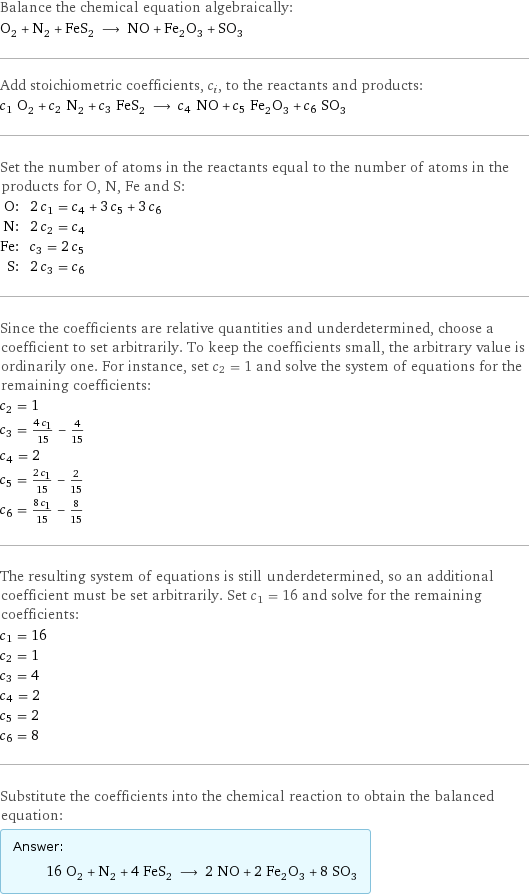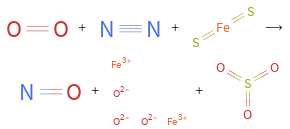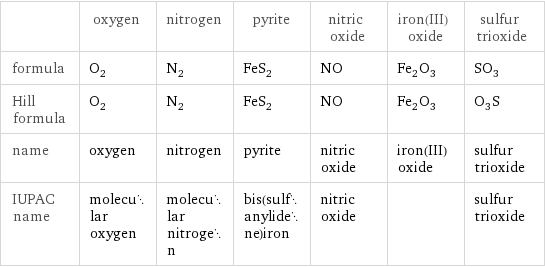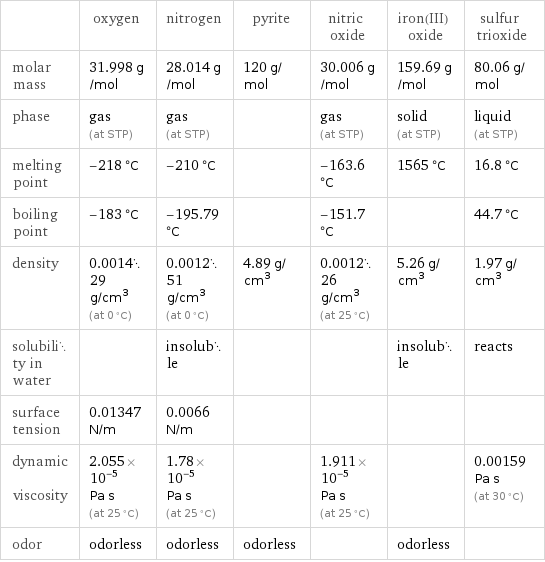Input interpretation

O_2 oxygen + N_2 nitrogen + FeS_2 pyrite ⟶ NO nitric oxide + Fe_2O_3 iron(III) oxide + SO_3 sulfur trioxide
Balanced equation

Balance the chemical equation algebraically: O_2 + N_2 + FeS_2 ⟶ NO + Fe_2O_3 + SO_3 Add stoichiometric coefficients, c_i, to the reactants and products: c_1 O_2 + c_2 N_2 + c_3 FeS_2 ⟶ c_4 NO + c_5 Fe_2O_3 + c_6 SO_3 Set the number of atoms in the reactants equal to the number of atoms in the products for O, N, Fe and S: O: | 2 c_1 = c_4 + 3 c_5 + 3 c_6 N: | 2 c_2 = c_4 Fe: | c_3 = 2 c_5 S: | 2 c_3 = c_6 Since the coefficients are relative quantities and underdetermined, choose a coefficient to set arbitrarily. To keep the coefficients small, the arbitrary value is ordinarily one. For instance, set c_2 = 1 and solve the system of equations for the remaining coefficients: c_2 = 1 c_3 = (4 c_1)/15 - 4/15 c_4 = 2 c_5 = (2 c_1)/15 - 2/15 c_6 = (8 c_1)/15 - 8/15 The resulting system of equations is still underdetermined, so an additional coefficient must be set arbitrarily. Set c_1 = 16 and solve for the remaining coefficients: c_1 = 16 c_2 = 1 c_3 = 4 c_4 = 2 c_5 = 2 c_6 = 8 Substitute the coefficients into the chemical reaction to obtain the balanced equation: Answer: | | 16 O_2 + N_2 + 4 FeS_2 ⟶ 2 NO + 2 Fe_2O_3 + 8 SO_3
Structures

+ + ⟶ + +
Names

oxygen + nitrogen + pyrite ⟶ nitric oxide + iron(III) oxide + sulfur trioxide
Equilibrium constant
![Construct the equilibrium constant, K, expression for: O_2 + N_2 + FeS_2 ⟶ NO + Fe_2O_3 + SO_3 Plan: • Balance the chemical equation. • Determine the stoichiometric numbers. • Assemble the activity expression for each chemical species. • Use the activity expressions to build the equilibrium constant expression. Write the balanced chemical equation: 16 O_2 + N_2 + 4 FeS_2 ⟶ 2 NO + 2 Fe_2O_3 + 8 SO_3 Assign stoichiometric numbers, ν_i, using the stoichiometric coefficients, c_i, from the balanced chemical equation in the following manner: ν_i = -c_i for reactants and ν_i = c_i for products: chemical species | c_i | ν_i O_2 | 16 | -16 N_2 | 1 | -1 FeS_2 | 4 | -4 NO | 2 | 2 Fe_2O_3 | 2 | 2 SO_3 | 8 | 8 Assemble the activity expressions accounting for the state of matter and ν_i: chemical species | c_i | ν_i | activity expression O_2 | 16 | -16 | ([O2])^(-16) N_2 | 1 | -1 | ([N2])^(-1) FeS_2 | 4 | -4 | ([FeS2])^(-4) NO | 2 | 2 | ([NO])^2 Fe_2O_3 | 2 | 2 | ([Fe2O3])^2 SO_3 | 8 | 8 | ([SO3])^8 The equilibrium constant symbol in the concentration basis is: K_c Mulitply the activity expressions to arrive at the K_c expression: Answer: | | K_c = ([O2])^(-16) ([N2])^(-1) ([FeS2])^(-4) ([NO])^2 ([Fe2O3])^2 ([SO3])^8 = (([NO])^2 ([Fe2O3])^2 ([SO3])^8)/(([O2])^16 [N2] ([FeS2])^4)](../image_source/a9b7162b07be9d306d46e2a5c198f55b.png)
Construct the equilibrium constant, K, expression for: O_2 + N_2 + FeS_2 ⟶ NO + Fe_2O_3 + SO_3 Plan: • Balance the chemical equation. • Determine the stoichiometric numbers. • Assemble the activity expression for each chemical species. • Use the activity expressions to build the equilibrium constant expression. Write the balanced chemical equation: 16 O_2 + N_2 + 4 FeS_2 ⟶ 2 NO + 2 Fe_2O_3 + 8 SO_3 Assign stoichiometric numbers, ν_i, using the stoichiometric coefficients, c_i, from the balanced chemical equation in the following manner: ν_i = -c_i for reactants and ν_i = c_i for products: chemical species | c_i | ν_i O_2 | 16 | -16 N_2 | 1 | -1 FeS_2 | 4 | -4 NO | 2 | 2 Fe_2O_3 | 2 | 2 SO_3 | 8 | 8 Assemble the activity expressions accounting for the state of matter and ν_i: chemical species | c_i | ν_i | activity expression O_2 | 16 | -16 | ([O2])^(-16) N_2 | 1 | -1 | ([N2])^(-1) FeS_2 | 4 | -4 | ([FeS2])^(-4) NO | 2 | 2 | ([NO])^2 Fe_2O_3 | 2 | 2 | ([Fe2O3])^2 SO_3 | 8 | 8 | ([SO3])^8 The equilibrium constant symbol in the concentration basis is: K_c Mulitply the activity expressions to arrive at the K_c expression: Answer: | | K_c = ([O2])^(-16) ([N2])^(-1) ([FeS2])^(-4) ([NO])^2 ([Fe2O3])^2 ([SO3])^8 = (([NO])^2 ([Fe2O3])^2 ([SO3])^8)/(([O2])^16 [N2] ([FeS2])^4)
Rate of reaction
![Construct the rate of reaction expression for: O_2 + N_2 + FeS_2 ⟶ NO + Fe_2O_3 + SO_3 Plan: • Balance the chemical equation. • Determine the stoichiometric numbers. • Assemble the rate term for each chemical species. • Write the rate of reaction expression. Write the balanced chemical equation: 16 O_2 + N_2 + 4 FeS_2 ⟶ 2 NO + 2 Fe_2O_3 + 8 SO_3 Assign stoichiometric numbers, ν_i, using the stoichiometric coefficients, c_i, from the balanced chemical equation in the following manner: ν_i = -c_i for reactants and ν_i = c_i for products: chemical species | c_i | ν_i O_2 | 16 | -16 N_2 | 1 | -1 FeS_2 | 4 | -4 NO | 2 | 2 Fe_2O_3 | 2 | 2 SO_3 | 8 | 8 The rate term for each chemical species, B_i, is 1/ν_i(Δ[B_i])/(Δt) where [B_i] is the amount concentration and t is time: chemical species | c_i | ν_i | rate term O_2 | 16 | -16 | -1/16 (Δ[O2])/(Δt) N_2 | 1 | -1 | -(Δ[N2])/(Δt) FeS_2 | 4 | -4 | -1/4 (Δ[FeS2])/(Δt) NO | 2 | 2 | 1/2 (Δ[NO])/(Δt) Fe_2O_3 | 2 | 2 | 1/2 (Δ[Fe2O3])/(Δt) SO_3 | 8 | 8 | 1/8 (Δ[SO3])/(Δt) (for infinitesimal rate of change, replace Δ with d) Set the rate terms equal to each other to arrive at the rate expression: Answer: | | rate = -1/16 (Δ[O2])/(Δt) = -(Δ[N2])/(Δt) = -1/4 (Δ[FeS2])/(Δt) = 1/2 (Δ[NO])/(Δt) = 1/2 (Δ[Fe2O3])/(Δt) = 1/8 (Δ[SO3])/(Δt) (assuming constant volume and no accumulation of intermediates or side products)](../image_source/e7bbdeace49638e9ba3e1115bf8d5361.png)
Construct the rate of reaction expression for: O_2 + N_2 + FeS_2 ⟶ NO + Fe_2O_3 + SO_3 Plan: • Balance the chemical equation. • Determine the stoichiometric numbers. • Assemble the rate term for each chemical species. • Write the rate of reaction expression. Write the balanced chemical equation: 16 O_2 + N_2 + 4 FeS_2 ⟶ 2 NO + 2 Fe_2O_3 + 8 SO_3 Assign stoichiometric numbers, ν_i, using the stoichiometric coefficients, c_i, from the balanced chemical equation in the following manner: ν_i = -c_i for reactants and ν_i = c_i for products: chemical species | c_i | ν_i O_2 | 16 | -16 N_2 | 1 | -1 FeS_2 | 4 | -4 NO | 2 | 2 Fe_2O_3 | 2 | 2 SO_3 | 8 | 8 The rate term for each chemical species, B_i, is 1/ν_i(Δ[B_i])/(Δt) where [B_i] is the amount concentration and t is time: chemical species | c_i | ν_i | rate term O_2 | 16 | -16 | -1/16 (Δ[O2])/(Δt) N_2 | 1 | -1 | -(Δ[N2])/(Δt) FeS_2 | 4 | -4 | -1/4 (Δ[FeS2])/(Δt) NO | 2 | 2 | 1/2 (Δ[NO])/(Δt) Fe_2O_3 | 2 | 2 | 1/2 (Δ[Fe2O3])/(Δt) SO_3 | 8 | 8 | 1/8 (Δ[SO3])/(Δt) (for infinitesimal rate of change, replace Δ with d) Set the rate terms equal to each other to arrive at the rate expression: Answer: | | rate = -1/16 (Δ[O2])/(Δt) = -(Δ[N2])/(Δt) = -1/4 (Δ[FeS2])/(Δt) = 1/2 (Δ[NO])/(Δt) = 1/2 (Δ[Fe2O3])/(Δt) = 1/8 (Δ[SO3])/(Δt) (assuming constant volume and no accumulation of intermediates or side products)
Chemical names and formulas

| oxygen | nitrogen | pyrite | nitric oxide | iron(III) oxide | sulfur trioxide formula | O_2 | N_2 | FeS_2 | NO | Fe_2O_3 | SO_3 Hill formula | O_2 | N_2 | FeS_2 | NO | Fe_2O_3 | O_3S name | oxygen | nitrogen | pyrite | nitric oxide | iron(III) oxide | sulfur trioxide IUPAC name | molecular oxygen | molecular nitrogen | bis(sulfanylidene)iron | nitric oxide | | sulfur trioxide
Substance properties

| oxygen | nitrogen | pyrite | nitric oxide | iron(III) oxide | sulfur trioxide molar mass | 31.998 g/mol | 28.014 g/mol | 120 g/mol | 30.006 g/mol | 159.69 g/mol | 80.06 g/mol phase | gas (at STP) | gas (at STP) | | gas (at STP) | solid (at STP) | liquid (at STP) melting point | -218 °C | -210 °C | | -163.6 °C | 1565 °C | 16.8 °C boiling point | -183 °C | -195.79 °C | | -151.7 °C | | 44.7 °C density | 0.001429 g/cm^3 (at 0 °C) | 0.001251 g/cm^3 (at 0 °C) | 4.89 g/cm^3 | 0.001226 g/cm^3 (at 25 °C) | 5.26 g/cm^3 | 1.97 g/cm^3 solubility in water | | insoluble | | | insoluble | reacts surface tension | 0.01347 N/m | 0.0066 N/m | | | | dynamic viscosity | 2.055×10^-5 Pa s (at 25 °C) | 1.78×10^-5 Pa s (at 25 °C) | | 1.911×10^-5 Pa s (at 25 °C) | | 0.00159 Pa s (at 30 °C) odor | odorless | odorless | odorless | | odorless |
Units
